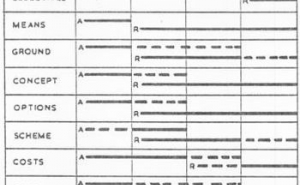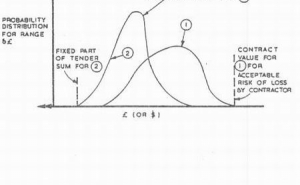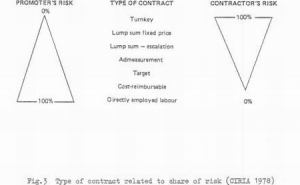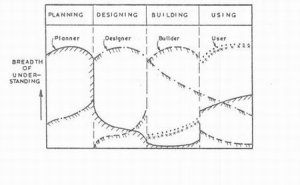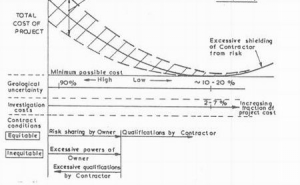You are here
Efficacy and equity of the management of large underground projects
Rapid Excavation and Tunneling Conference, May 03-07 1981
ABSTRACT
There are two essential features of administrative practices in tunnelling in order to provide proper encouragement to innovative and economic tunnelling: first, that there should be a continuity in the decision making at all stages so that the full implications of decisions in early stages of planning and design are understood; second, that there should be appropriate provision for variation so that the greatest possible benefit can be derived from modifying the working scheme in relation to the characteristics of the ground and from study of its behaviour during execution of the work. rumples are given from the Authors* experience as to the benefits to be derived from the application of such principles.
INTRODUCTION
The technical and organisational aspects of civil engineering projects are too often treated apart and, in the extreme, handled for a single project by different people, with different backgrounds and understanding of the demards for good engineering, who remain inadequately co-ordinated. In tunnelling in particular the only certainty is that the outcome will not correspond to initial expectation; it is imperative, for effective and economic results, that a project must be viewed throughout its evolution and execution as an entity, with full continuity across all its phases of development.
Of course there is a need for particular (and probably specialist) expertise in many respects: for a large underground urban railway project for example, entailing expertise in the fields of transport economics, physical planning and development, geology, geotechnics, probably several different aspects of tunnelling and in railway engineering, operating and maintenance, to name the most significant. It remains essential to ensure a degree of continuity in control throughout so that optimization of the whole may take precedence over optimization of a specific aspect where some degree of compromise is called for.
Figure 1 indicates in a simplified way the degree of interaction between decisions made in the initial "upstream" stages of a project and their consequences in subsequent "downstream" phases. The general implication of this diagram is that actions taken and decisions made in early phases must, for successful outcome, take account of their impingement upon actions and decisions at other stages. This entails a degree of awareness of these consequences by no means evident in many recent large underground projects.
In many aspects of engineering the recent trend has been away from a directly deterministic approach towards the introduction, in one of a number of alternative methods, of the notion of uncertainty. Where the engineering can be expressed with complete confidence and certainty, then the contractual relationships may be expressed with a comparable certainty, at least in relation to the engineering concept and work content. As soon as uncertainty is introduced which bears upon the finished project, the nature and extent of the work in its achievement or in its consequential effects, we can apply the same argument towards a flexibility in the contractual basis as we do in the technical response to corresponding uncertainty in engineering terms.
This concept may be modelled by the diagram in Figure 2 which considers extreme cases of (1) a fixed price contract and (2) a contract whose value is related to the conditions encountered, for circumstances in which these are uncertain. fine shape of curve (1) has to be estimated at the time of Tender and the speculative degree of Tender (1) is incomparably greater than Tender (2). Lucky indeed is the Contractor who has pitched his Tender for (1) as indicated or higher, is reasonably correct in his assumptions and has been awarded the Contract. The Contractor will be disinclined to innovate and he will be tempted, in such uncertainty, to cut corners, often unwittingly, to maximise profit; hence the wide range of possible costs to the Contractor. For Case (2), innovation is favoured with appropriate adaptability to match the conditions encountered so the probable cost to the Contractor is reduced and the range of variability of cost confined; for the extreme case considered, the Contractor is assumed to recover full costs incurred. The skill comes in so devising the contract form and structure, between these two extremes, as to minimise costs for reasonable profit to the Contractor, with appropriate control on behalf of the Promoter (Figure 3). This is the essence of efficacy and equity.
PROJECT CONTINUITY
The interaction between the several phases of a project is grossly over-simplified by Figure 1. We cannot usually subdivide the work into such neat parcels nor can we state precisely what decisions are taken at each phase. It is the sheer imprecision of the process which helps obscure when and what decisions are taken, and part of the object of this brief paper is to attempt to clarify this state of affairs. Throughout the process the assumption is made that there is a unique decision taker; in fact there is, or should be, a single line of command concerning decisions within expressly stipulated areas of devolution of decision taking, in effect to ensure that no one decision is made without awareness as to how it affects others involved in this process. But too often the time dimension is forgotten so that although contemporaneous decisions may be coordinated, effects upon subsequent decisions are obscure. To correct this condition we must consider the nature of the decision maker. Essentially, advice that he receives on every aspect must provide answers to particular questions and one of the arts of decision making lies in correctly framing these same questions, and remaining perceptive to the limitations beyond his own field of expertise. Good engineering entails the ability to make a synthesis between the many aspects of knowledge and expectation. This pre-supposes the ability to ask the right question at the right time. So we can start by establishing that the overall coordinating function is appropriate to an engineer. If early decisions are not to introduce subsequent costly consequences then some way must be devised to ensure adequate prescience in this respect. Otherwise we shall find ourselves perpetuating the mistake made, for example, from planning an underground railway on traffic requirements without any thought to the gross geological complications that these, uncorrected, may entail in determining the route. We are concerned here with the difference in results between attempting to optimize, by a continuous process of reduction of options, all the major parameters throughout evolution of the project or the more expensive alternative of attempting to optimize each in turn within the constraints imposed by separate optimization of those already determined.
If we then continue with the oversimplification of Figure 1 and consider the attitudes of the parties concerned with the specific continuation to each of the four stages, we can arrive at a diagram on the lines of Figure 4 in which the ordinate represents depth of understanding and we consider, in gross oversimplification, the roles of Planner, Designer, Builder and User to keep to comparable nomenclature. What springs immediately from this diagram is that if, for example, the designer is not appointed until completion of the planning stage, then the Planner has to have a fax deeper understanding of the downstream consequences of his planning since the designer is not there to protect the position of himself and his followers.
There is no single solution to this criterion for continuity but it is the view of the Authors based on their direct experiences in satisfactory (and unsatisfactory) roles that the notion of the Engineer involved and accepting responsibility in defined ways between the concept and the completion of the project provides the most satisfactory means of continuity.
The diagram of Figure 4 is drawn around this arrangement and would need recasting for any other acceptable solution.
MANAGEMENT AND ENGINEERING
Our concern here is with the not too well understood inter-relation between management and engineering, (the latter taken here as embracing the technical content, including all aspects of engineering judgement). We cannot consider the relationship without the notion of uncertainty. For example Fig.3 indicates in relation to type of Contract (one only of the several aspects how different basic types of Contract make different provision for uncertainty in cost to the promoter and the contractor. By far the greatest factor in contractual risk in tunnelling is normally related to the unknown aspects of the ground. A high degree of certainty of cost to the Promoter is a desirable aim but this can only be achieved where conditions permit a lump sum contract (see Fig.2). The Promoter is accepting unnecessarily high costs of adopting such a contract basis when the technical risk is high.
Unless a contractor is a charitable organisation - and few in the Authors' experience are - then the less the provisions for variation and for the objective valuation of such variations, the greater the allowance he must make at the time of tender to cover for uncertainty. The alternative is equally unsatisfactory in that he may be able to establish that information provided at time of tender was such as to mislead a (n experienced) contractor into underestimating the nature of the difficulties. There is nothing clever, or beneficial in the out-turn, in persuading a contractor to undertake a project with an underestimate of the problems involved, where these are known to, or suspected by, the beguiling party. The technique simply leads to the legal profession becoming the one party to profit from tunnelling at a great loss to society and to the construction professionals and work forces engaged in underground construction. Furthermore, such a procedure enhances the probability of hazard during construction (Muir Wood, 1975)
A similar argument may be applied to the contractual arrangements (or Agreements) between other parties concerned in the project. The sharper the definition of the task in planning and in designing (also in supervision and in providing for the optimal arrangements for operation and maintenance) the more reasonable is it to aim towards a lump sum fee and clear cut terms of reference. Only those with experience through such processes know how the unexpected tend to be the rule rather than the exception.
In consequence it is wise always to lean in the direction of excessive scope for variation rather than excessively Procrustean relations. For a professional to be in a position of knowing that he cannot within his fee satisfactorily undertake a service, which has expanded, without personal loss is a position of much disbenefit to all parties concerned.
GOOD TUNNELLING AND CONTRACTUAL RISK
A number of recent contributions have been made nationally and internationally towards the object of defining the sources of risk in a contract and in establishing how best, in the interest of the common good, these are shared among the pasties concerned. (ITA report 1979 CIRIA Report 1978). The latter, which builds upon practice in the United Kingdom and nowadays largely accepted in Austria (and certain other European countries), has a number of essential features, the most important of which may be slmmmarised thus:
- Generally attribute acceptance of risk to the party best able to control its incidence or, for minor risk, to make reasonable provision for its cost.
- Provide appropriate encouragement to use methods of construction that show best prospects, in. the available knowledge at any time, of an economic result.
- Provide appropriate flexibility for change in construction methods to follow the range of variation in ground and other conditions foreseeable by a knowledgeable engineer.
- Simple and equitable arrangements for disposal of disputes.
- These different aspects of a single problem cannot be treated in isolation one from the other but need a little amplification in particular respects.
Once we start to attribute risk we identify the common interest (which is always there but often obscured) in the reduction of uncertainty about the ground. It is not good enough to calculate the percentage expected cost of a project spent on site investigation, for example, as if there were some general optimal figure. Experience elsewhere in comparable circumstances may provide some guidance but, in particular and not universally evidenced, site investigation should be designed in relation to the special features and uncertain_ ties of the ground, related to construction as well as design, with incremental costs of extra investigation justified by the expectation of a reasonably high benefit to cost ratio of the results obtained (and of course it is still a benefit to discover more about special problems to be encountered and to be prepared for). We must here repeat that the capacity to vary the scheme of construction in relation to changes in the ground is highly dependent upon the tunnelling technique. Thus, any of the techniques based on the observational method (whereby predictions in ground/support behaviour are constantly monitored by observation and measurement, using usually a calculated or estimated set of alternative schemes of construction in relation to any one range of observations) necessitates considerable foresight into the range of conditions but usually less dependance on limitations of variability than a more specific and perhaps highly mechanised scheme of construction. The New Austrian Tunnelling Method (NATM) is the best known exponent of the observational method in tunnelling although, at the present time, the development of such methods worldwide can be seen against the particular national conditions of tunnelling and, in particular, the extent to which appropriate contract conditions have been adopted. The principles above are illustrated in their effects by Figure 5.
Brief examples of such techniques in the experience of the Authors, with indication of the nature of cost savings and other benefits, are provided at the end of this paper.
If the Contractor is to be encouraged to use particular methods of construction which promise economic benefit for expected conditions, then he must be given the answer to the question 'If not, what?'. In its turn this may require the Engineer to go further than simply providing all site investigation data (which clearly should be done and should we repeat be designed as much to answer questions of construction as questions of design) but also to guide the Contractor to the interpretation to put upon them if these are to serve as a basis of reference for variation. Involvement of the Engineer in an overall capacity much enhances the likelihood of sufficient awareness at the investigation stage of the main problems of construction to be investigated. We are here helping to solve two problems at once:
to provide a set of reference conditions against which the effects of changed conditions can be measured and computed (and it is remarkable how prescient some Engineers expect Contractors to be once all parties axe informed by hindsight!).
to avoid the need for a Contractor to provide in the fixed part of his Tender Sum for the expensive, albeit improbable, circumstances of failure of a method on account of departure of the condition of the ground beyond tolerable characteristics.
We then have to consider, by the means above, how to categorise the ground into grades, normally related to the particular scheme for supports and so forth, so that appropriate prices may be given for each. This is of course nowhere near the end of the road in evaluating variation but it provides a base to remove much of the antagonism and anguish. In general, once a Contractor has no chance of making a profit, the project is likely to be a partial failure - not for the Contractor alone.
However, disputes will arise in the most orderly arrangements and this prospect must be foreseen. The British tradition of its independent Engineer has much to commend it in providing throughout an arbiter on whose judgement depends the interpretation of the contract or on the foreseeability of the unexpected. Even in the United Kingdom, there are ominous trends of encroaching upon the powers (but not usually the concomitant duties!) of the Engineer, by those who appear not to understand the full import of this action in preventing an equitable (and hence efficacious and economic) operation of the Contract. These encroachments take two forms:
a curb on the Engineer's power, with interpretation of the Contract in relation to structure and variation reserved to an employer's Contracts or similar department, a body of legalistic people who are insulated from the salutary effect of bearing responsibility. This results in encouraging a lesser breed of Engineer, inadequately objective.
a tendency to oppose reasonable claims by Contractors forcing arbitration, with the associated and sometimes grossly inequitable threat to sue the Engineer if the Employer loses the case; the obverse is an increasingly litigacious attitude among Contractors.
This trend shows total unawareness of the nature of risk and of the Employer's contribution (it is his ground!) to the problems. It should be possible to establish whether or not the Engineer has been negligent in the nature of his undertaking to his Employer. It should not be necessary to debate this from the premise that if he has been in error in his judgement, negligence necessarily follows. On the contrary, if the benefits of the notion of reference conditions are to be achievable then the implication is that the Engineer must from time to time be wrong in his initial definition of expectations (or the Contractor would be satisfied to accept his own interpretation of the ground data without the protection of 'reference conditions'). These reference conditions will err towards optimism to avoid need to negotiate 'negative' claims. In fact, for this particular example of a workable system, reliance must be placed on the Engineer's judgement; he should be dealing with engineers who can question his or her judgement but not allowed to be vindictive on every occasion of fallibility of judgement. If he is expected to be infallible then a fixed price contract should be preferred at the acceptance of the high cost to be paid. We are concerned with total systems, not with selecting particular parts that swing the interest unduly in the direction of one party to the Contract only.
The Contract system in Austria, as applied to the operation of the NATM, relates payment for support to geological conditions, the classification system being determined jointly between Employer and Contractor and the method of excavation and means of support being broadly the responsibility of the Contractor. Technical advance and economic costs have been encouraged by this approach; at the present time unit rates for tunnel construction are on average about 200/0 below costs in Germany and 3C16 below costs in Switzerland.
Much recent development in tunnelling, development only justified by contributing to reductions in time and cost of construction, could not have been achieved outside a basis of risk-sharing and of variation of the scheme of construction; such variation needs to conform to knowledge of behaviour of the ground, and of its variability, only acquired during the course of construction. Without the protection of a code of conduct on some such lines as those described above, the Engineers for sheer self protection will cling to the traditional, safe approach; the costs of projects will be unnecessarily high (and we are concerned with factors of, say 1.5 to 5 or more and innovation will be thwarted. Much of innovation is only possible as a result of extending practical experience; its successful adoption in one project may therefore be a necessary concomitant of its adoption in a more testing subsequent project.
EXAMPLES OF APPLICATION OF THE PRINCIPLES
Successful civil engineering must compound theory and practice.
It may therefore be instructive to indicate, for those unfamiliar with the principles set out above, four examples of brief accounts of typical applications.
Example 1
A rock tunnel of 100 sq.metres section had to traverse a difficult 200m long zone of quartz-mylonite under a 25m depth of cover. The material was uniform grained (0.02-0.07 mm). Short-term cohesion resulted from the natural moisture content.
After trial excavation at crown level, timber forepoling had to be used to resist heavy ground loading. On resumption of work, after a fortnight's break over Christmas, the rock collapsed into the cavity. Tunnel driving resumed, after considering proposals for remedial work, with future interruptions to progress limited to a maximum period of 7 hours, sidewalls being advanced ahead, subsequently enlarged to full-face without problems. When the rock improved (to weak phyllites and sericite schist) full-face driving was resumed, the face somewhat domed and benched in two steps to improve stability.
Example 2
A three-lane road tunnel had to traverse a talus with internal friction of about 36º and very sligh cohesion, the overburden thickness varying between 3-20 metres. Excavation started for a sidewall heading but a fall occurred on account of the low overburden. The Contractor took responsibility of changing to a top heading, accepting local unavoidable falls, the steel arches with mesh being covered in such areas with a bitunminous fabric sheet. After shotcreting from within the tunnel the cavity above was refilled. On account of the high angle of friction, the change in overburden weight was accepted by the arch without problem, there being no great restriction on vertical movements of the surface.
Example 3
The 80km Orange-Fish tunnel was known to penetrate a series of sandstone/siltstones and dolomitic dikes and sills with possible problems of gas and of water. The Contract was based upon several alternative forms of ground support which in the event needed to be varied with experience, with the evolution of criteria in monitoring (mainly of rock convergence) to establish the adequacy of that adopted for any particular length of tunnel. Many problems were encountered but ultimately the criterion remained as to the degree of departure from the "reference conditions" (not in fact so called for this project) and the appropriate adjustment in payment. Initial support was largely based upon different patterns of rock bolts and the general use of shotcrete of different thicknesses and reinforcement.
Example 4
The fundamental basis for the design of the Heathrow Cargo Tunnel, which permitted a cost of probably less than 50% of a more conventional approach, assumed the practicability of:
- keeping the tunnel near the surface with a total cover of appreciably less than the diameter and the acceptance of a perched water table, locally separated by no more than about 1.2m above the crown of the tunnel
- adopting a system of tunnelling which required a continuous clay cover
- constructing the tunnel full-face without pilot.
Unless the responsibility for these criteria had been removed from the Contractor it is certain that the highly economical method proposed would not have been accepted, except at an additional cost which would have eroded much (or even all) of the achieved saving.
CONCLUSIONS
The Authors hope that the principles set out in the paper and the brief account of their applications will help to a more general acceptance of the managerial principles for economic tunnelling, and for relatively prosperous protagonists.
It should be emphasised that the benefits of a more general adoption of these principles fall: upon the Promoter (Owner or Employer) with a cheaper, faster and more reliable project; on the "Engineer, with greater scope for his ingenuity and upon the Contractor with greater confidence for a fair return for his skill and resources. The only losers are likely to be the profession's vultures. The alternative is likely to be continuing unnecessary escalation in costs, lack of economic innovation and the increased impregnability of the legal profession as the only beneficiary of the result.
REFERENCES
- International Tunnelling Association Contractual sharing of risk Bron, May 1979.
- Construction Industry Research and Information Association Tunnelling - improved contract practices CIRIA Report 79 London, May 1978.
- Muir Wood, A.M. Tunnel hazards: UK experience Hazards in tunnelling and on Falsework. Inst.C.E.London,1975, PP 47-59.
